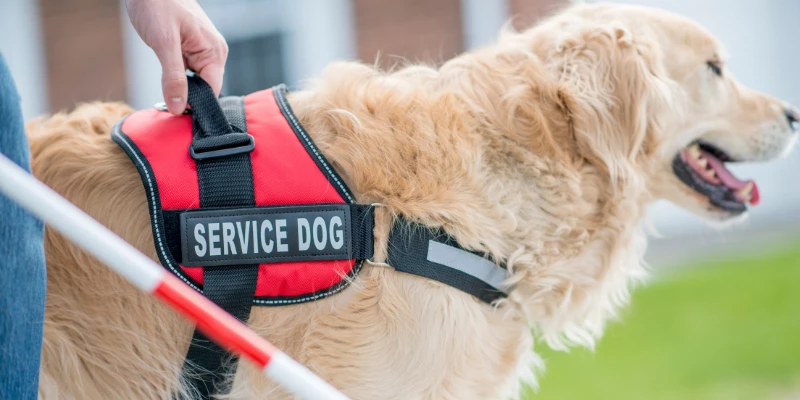Some people have this misunderstanding that all dogs they see are service dogs, but that isn’t always the case. Service animals are the most widely-used animals that you will see out in public.
Service dogs have the most access in public, but what other dogs might you see?
Aside from service dogs, you may also encounter people with an emotional support animal or you may even see a therapy dog depending on where you are when you see the animal.
Service dogs have the most public access because they are allowed in most public places based on the ADA requirements for people with disabilities.
Emotional support animals have certain access, such as being allowed on an airplane with their handler while therapy dogs are typically found in hospitals and other areas where therapy may be needed.
None of this explanation probably makes much sense to you for each category of animal, but I will describe what each type of animal is used for and where they are most commonly allowed.
Let’s first look at what a service dog is to help you get a better understanding.
Then I’ll describe what emotional support dogs are and what therapy dogs are used for.
What Is a Service Dog?
A service dog is defined under the ADA guidelines as a dog that has been trained to perform tasks or to do some type of work regarding a disability their handler has.
The ADA also states that all service dogs need to be trained to be in public settings and gives establishment owners the right to reject or remove service dogs and their handlers from their establishment if the dog is disruptive and can’t be controlled by their handler.

The ADA requires admittance to service dogs for any place where the public is allowed to go. This includes public transportation, restaurants, malls, airplanes, etc.
Service animals are also allowed in most government and state facilities.
What Are Emotional Support Animals?
Emotional support animals are animals that provide emotional support for handlers with mental conditions such as anxiety, depression, or other psychological disorder by being a comfort through companionship and affection to help with their handler’s mental state.
Emotional support animals have to be prescribed by a licensed mental health professional or therapist for help with the mental condition their handler suffers from.

If a professional has not provided a letter stating that an animal is needed for emotional support, most places won’t see the animal as a legal support animal.
Emotional support animals aren’t just limited to dogs. Other emotional support animals, also known as ESAs, may include miniature horses, cats, pigs, monkeys, and ducks.
Dogs are still the most used ESAs, but cats are gaining popularity as emotional support animals.
Difference Between Emotional Support Animals & Service Dogs
Emotional support animals differ from service dogs because they are not trained to perform tasks or do work for their handler with a disability. They are just used for emotional support and comfort.
Since emotional support animals receive no training, they are not provided the same access as service dogs in public settings.
ESAs are allowed to board airplanes with their handlers and should be allowed in residences with their handlers even if the landlord has a no pet policy, provided the handler has a letter from their doctor prescribing the animals as support animals.
However, the landlord can potentially deny residence to an emotional support animal and even a service dog in certain situations.
If the landlord believes the animal poses a threat to others or has the potential to cause substantial physical damage to other’s property, the animal can be denied access.
Emotional support animals aren’t provided the same access as service animals under the ADA requirements and can’t be taken in public places like service dogs.
For example, Walmart has to allow service animals in their stores due to the requirements of the ADA for people with disabilities.
However, emotional support animals are not permitted because they aren’t listed under the ADA as service dogs because they have not received any proper training to perform tasks for a disability.
Although ESAs aren’t allowed access to most public places that service dogs are allowed access to, it is still important to have an ESA that is trained in obedience and knows simple verbal commands to ensure the animal is behaving properly when in public.
Since ESAs are allowed on airplanes and other places where “pets” would normally not be allowed, it is important to have a well-behaved ESA to ensure the residence or airline has no reason to deny access.
Going through the proper channels and getting a letter from a doctor stating the animal is needed for emotional support will help a lot when trying to move into a residence that doesn’t allow pets or in any other situation where proof is required.
Such proof isn’t required for service dogs because service dogs do not need any documentation or certifications to prove legitimacy as service dogs, but emotional support animals need to be prescribed by a professional to be legit support animals.
What Are Therapy Dogs?
Therapy dogs are dogs that receive extensive training but their training is for different tasks and work than that of a service dog.
There are some similarities between therapy dogs and service dogs, such as both types should have well-mannered behavior while in public.

Therapy dogs should be friendly dogs because they are trained to visit certain public places, such as hospitals, schools, and nursing homes to provide therapy for individuals that need physiological and psychological support.
Difference Between Therapy Dogs & Service Dogs
While therapy dogs and service dogs both receive training, a service dog receives training for a disability their handler has while a therapy dog receives training to visit public places like hospitals and schools to help provide psychological and physiological therapy to people other than their handler.
Therapy dogs don’t service their handler by helping them with a disability but service the community by providing help to people found at these facilities such as hospitals and schools.
Because of that, therapy dogs are encouraged to be social and friendly.
They are encouraged to interact with various types of people while they are working, whereas service dogs are supposed to be focused on their handler and not the general public to perform their duties.
Therapy dogs are expected to be friendly and have a non-aggressive temperament to provide positive experiences to people that may be down or saddened by a physical or mental condition they have.
One of the main differences between emotional support animals, service dogs, and therapy dogs is what services they provide, while another difference is where they are allowed to provide these services.
Emotional support animals provide comfort and support to their handler or someone within the care of the handler.
Therapy dogs provide comfort, support, and positive experiences to people other than their handler and are usually found in certain public settings.
Service dogs provide services to their handler based on training received to help with their handler’s disabilities.
Service dogs are allowed in most public settings because they’ve been trained. Therapy dogs are trained for specific public settings such as schools and hospitals.
Emotional support animals require no training so they aren’t allowed in public settings like therapy and service dogs (one exception is airplanes).
Recap
I hope this article was able to shed some light on the difference between service dogs, emotional support dogs, and therapy dogs.
As you have read, there are distinct differences between all three.
Service dogs are allowed the most access while emotional support and therapy dogs are only allowed access in certain areas and certain public places.
Service and therapy dogs require training while emotional support animals do not.
I have written other articles that dive deeper into what service dogs are.
You can check out some of those in the links below. For now, that’s all I have!
I hope you found the answer or gained the knowledge you were looking for in this article.
Other Articles I’ve Written That May Interest You
- What are Service Dogs? Detailed Guide with 11 Types & More
- 12 Tips to Spot a Fake Service Dog or Poorly Trained Dogs
- Are Dogs Allowed in Walmart? Home-Depot? 40 Pet-Friendly Stores
- How do You Register or Train Your Dog to Become a Service Dog
References





